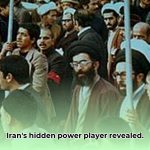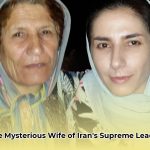Ever heard of Mansoureh Khojasteh Bagherzadeh? Probably not. She’s the wife of Iran’s Supreme Leader, Ali Khamenei, and she’s a mystery. We know almost nothing about her public life, but that doesn’t mean she’s powerless. This article is a deep dive into who she might be and what kind of influence she might have – from behind the scenes, of course. We’ll look at the known facts, her background, family connections, and then we’ll try to piece together how she might be shaping events in Iran, even if indirectly. It’s like solving a complex puzzle – we’ll present what we know, acknowledge the gaps in our knowledge, and strive to decipher its meaning. Prepare for a revealing glimpse behind the curtain of Iranian power. For more details on her life, see her [biography](https://www.lolaapp.com/mansoureh-khojasteh-bagherzadeh-biography).
The Enigmatic Mansoureh Khojasteh Bagherzadeh: A Shadowy Figure in Iranian Politics
Mansoureh Khojasteh Bagherzadeh, the wife of Iran’s Supreme Leader Ali Khamenei, remains an elusive figure. Despite her proximity to immense power, she has remained largely out of the public eye. This begs the question: How influential is Mansoureh Khojasteh Bagherzadeh? What forces shape her role? This article delves into the scarce information available, exploring possibilities while acknowledging the inherent difficulties in constructing a complete picture of her political influence.
Unraveling the Mystery: What We Know (and Don’t Know)
Reliable information on Mansoureh Bagherzadeh is surprisingly limited. We know she was born into a merchant family in Mashhad, a significant city in Iran known for its religious importance. Her marriage to Khamenei occurred during a time of considerable political turmoil, and accounts suggest she provided unwavering support during his periods of imprisonment. She is also a mother to six children. However, beyond these fundamental biographical details, verified information becomes scarce. This lack of transparency makes it challenging to fully comprehend her role and impact within the Iranian political establishment. Even basic details, such as her precise birthdate, are subject to inconsistencies across various sources.
The Potential for Influence: Exploring Avenues of Power and Family Connections
Given her husband’s powerful position as the Supreme Leader, it is plausible to consider the potential for Mansoureh Bagherzadeh to wield influence, even if indirectly or behind the scenes. Her close relationship with Khamenei suggests she might serve as a trusted advisor, shaping his perspectives or influencing his decisions subtly. Could Mansoureh Khojasteh Bagherzadeh exert a direct influence on policy? While formal influence is difficult to ascertain, its possibility warrants consideration when analyzing the dynamics of Iranian political leadership.
Another potential avenue of influence stems from her family connections. For example, one of her sons holds a prominent position within the religious establishment. This connection could provide a pathway for influencing religious institutions and related policies. This might not manifest as direct control but rather through shaping cultural norms, expressing opinions on family values, or indirectly influencing personnel decisions.
It is crucial to recognize that the assessment of her role relies on inference and speculation, given the limited available facts. Definitive statements about the extent of her power or verifiable evidence of Mansoureh Khojasteh Bagherzadeh’s influence remain elusive.
Challenges in Research: Navigating Iran’s Opaque Political Landscape
Researching Mansoureh Bagherzadeh’s influence presents significant obstacles, primarily due to stringent information controls. Iran’s political system is notoriously opaque, hindering access to reliable information, especially concerning the family of the Supreme Leader. The government heavily restricts the country’s media, tightly controlling information flow about its inner workings. How difficult is it to research Mansoureh Khojasteh Bagherzadeh’s role? Even verifying simple biographical details proves challenging, posing significant obstacles for any researcher attempting to gain clarity. This inherently complicates the task of determining the extent of her actual influence.
Understanding the Context: Culture, Power, and Secrecy
Comprehending Mansoureh Bagherzadeh’s potential influence requires acknowledging Iran’s cultural context. The country’s patriarchal societal norms may contribute to her largely avoiding public life. How does gender impact Mansoureh Khojasteh Bagherzadeh’s influence? This very absence from the public sphere raises intriguing questions. Could her influence be amplified by the secrecy surrounding her and her activities? This is not to suggest she secretly orchestrates events but that any influence she wields is likely subtle – a quiet force shaping family values, serving as a trusted confidante, or advocating for specific policies behind closed doors.
The Continuing Search for Answers: Future Research
The enigma surrounding Mansoureh Khojasteh Bagherzadeh presents a formidable challenge. While definitive proof of direct political manipulation remains elusive, the potential for her influence stemming from her proximity to power cannot be dismissed. Further research is essential to enhance our understanding of her role and influence, with a focus on promoting greater transparency within Iran’s power structure. New methods are needed to study informal power dynamics within opaque political environments. Understanding the roles of family members in these settings is crucial for a comprehensive analysis of Iranian politics. Overcoming information scarcity and restricted access requires innovative approaches. This journey of understanding is ongoing.
Future Research Directions: Potential Avenues
| Research Area | Methodology | Challenges | Potential Outcomes |
|---|---|---|---|
| Interviews (if feasible) | Conducting confidential interviews with individuals closely associated with the Khamenei family (if possible) | Gaining access, addressing risk aversion from interviewees, mitigating potential biases from interview subjects | Obtaining first-hand accounts of Mansoureh Bagherzadeh’s personality, relationships, and sphere of influence |
| Policy Analysis | Conducting detailed examinations of policy changes during Khamenei’s leadership, analyzing potential family ties | Establishing direct causal links between Bagherzadeh and policy changes, ensuring the availability of data | Identifying potential patterns or correlations between family interests and policy decisions |
| Comparative Studies | Studying the roles of spouses of other world leaders in similar political systems | Finding suitable parallels, navigating cross-cultural comparisons | Drawing comparisons and contrasts, offering a broader perspective on informal power structures |
| Analysis of Cultural Narratives | Examining how Mansoureh Bagherzadeh’s role is portrayed in Iranian media and society | Understanding media censorship, discerning official narratives versus more nuanced accounts and unofficial narratives | Unveiling how her image is constructed, and the intended messaging |
The enigma of Mansoureh Bagherzadeh’s influence highlights the inherent complexities of understanding power dynamics within opaque political systems. While definitive conclusions remain elusive, continuing to investigate this figure offers valuable insights into Iranian politics.
Unpacking Mansoureh Khojasteh Bagherzadeh’s Influence on Iranian Politics
Key Takeaways:
- Mansoureh Khojasteh Bagherzadeh’s life remains shrouded in secrecy, making speculation and conjecture about her influence inevitable.
- Her marriage to Supreme Leader Ali Khamenei positions her at the heart of Iranian power, yet her direct political involvement appears minimal.
- Indirect influence is the key focus of investigation, including potential advisory roles, shaping her husband’s perspective, and navigating internal power dynamics.
- The scarcity of public information presents formidable research challenges, reflecting the opaque nature of Iranian politics.
- Further investigation, ideally involving access to previously unseen documents or interviews with close associates, is crucial to determine the extent of her influence.
The Enigma and Influence of Family
Mansoureh Khojasteh Bagherzadeh’s life story is a puzzle wrapped in an enigma. Although she is the wife of Iran’s Supreme Leader, she largely remains a mystery. How do we begin to understand how did Mansoureh Khojasteh Bagherzadeh influence Iranian politics? The answer is multi-layered and, in many ways, difficult to grasp. What role did Mansoureh Khojasteh Bagherzadeh play in the Khamenei family decisions?
A Life in the Shadows
What we know for certain is that Ms. Bagherzadeh comes from a religious family and married Ali Khamenei in 1964. She has maintained a decidedly private profile, avoiding the public spotlight her husband inhabits. This deliberate choice of living outside the public glare raises many questions. Is it a strategic move to avoid scrutiny, a reflection of her values, or something else?
The Subtleties of Power and The Role of the Supreme Leader’s Wife
The challenge in addressing how did Mansoureh Khojasteh Bagherzadeh influence Iranian politics lies in understanding the subtle ways power operates, particularly within the Iranian political system. Direct influence, through formal political positions, may be absent, yet indirect influence is another matter. Imagine her role as a confidante, offering counsel to her husband. Consider her potential involvement in navigating intricate family relationships and their influence on decision-making processes. These unexplored avenues may reveal answers relating to her family’s overall influence.












